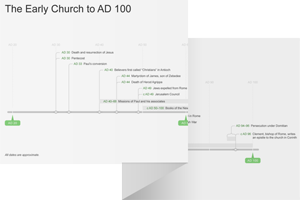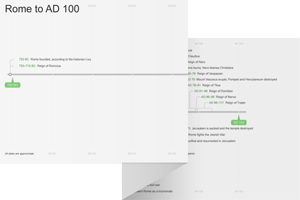4:1–11 Verses 1–11 introduce the throne-room vision of chs. 4 and 5. These chapters form one scene in which John is invited to behold future events (v. 1). He depends heavily on Moses, Ezekiel, and Daniel to describe the wonders he witnessed. The vision in these chapters includes the introduction of the Lamb and leads to the seal judgments in ch. 6. |
4:1 After these things Refers to the reception of the letters to the seven churches. The phrase used here indicates that John received this vision after the previous one.
former voice Belonging to the glorified Christ (1:10).
Come up here A summons to behold the visions (compare Ezek 3:12; 11:1).
which must take place after these things See Rev 1:19 and note.
4:2 Immediately I was in the Spirit This phrase occurs again in 17:3 and 21:10; it functions as a reminder that John is experiencing a prolonged vision. See note on 1:10.
a throne was set in heaven Suggests sovereignty and power. Various aspects of the vision in this chapter reflect aspects of Ezekiel’s and Isaiah’s visions of God (Ezek 1; Isa 6).
seated on the throne God (see Rev 4:8, 11).
4:3 jasper and carnelian stone Ezekiel describes Yahweh in a similar way (Ezek 1:26–27). In Exod 24:10, Moses also describes the divine presence of Yahweh using precious stones. Like Ezekiel and Isaiah, John does not attempt to give a precise description of God. Instead, he describes the overall effect of His glorious presence.
4:4 twenty-four elders May symbolize the 12 tribes of Israel and the 12 apostles, together representing the whole people of God. If true, this would fit with the context of Rev 2–3 of shared rulership for believers (see note on 2:7).
4:5 which are the seven spirits of God See 1:4.
4:6 sea of glass In Revelation, the sea likely symbolizes forces of chaos (see 13:1 and note; 21:1 and note). A calm sea points to God’s ability to subdue chaos and bring order.
four living creatures Possibly an allusion to the cherubim described in Ezek 1 and 10 (see note on Ezek 1:5), or the seraphim of Isa 6:2–3. The number four often represents the entire created order (e.g., Rev 7:1; Jer 49:36). Thus, these creatures may represent all living things worshiping God.
full of eyes in front and in back The multiplicity of eyes symbolically suggests unceasing vigilance or great wisdom (compare Ezek 1:18).
4:7 living creature was similar to a lion While John and Ezekiel both describe four living creatures in their visions, the descriptions vary. In Ezekiel 1, all four creatures are identical. In Revelation, each has only one face and resembles a different creature: A lion, an ox, a human, and a flying eagle. Ezekiel’s creatures have four wings, but John’s have six, like the seraphim in Isa 6:2. John’s creatures are full of eyes, but the eyes in Ezekiel are on the wheels that move the creatures.
4:8 Holy, holy, holy This echoes the song of the seraphim in Isa 6:2–3.
4:10 put down The phrase describes submission: the 24 elders, though wearing crowns, realize the ultimate source of their power—God Himself, the Great King.
4:11 our Lord and God Domitian (who ruled from ad 81–96), who may have been the Roman emperor during John’s exile on Patmos, demanded that his subjects call him “our lord and god.” John sets up a clear contrast between the true king and the one whose rule will eventually be done away with.

|
About Faithlife Study BibleFaithlife Study Bible (FSB) is your guide to the ancient world of the Old and New Testaments, with study notes and articles that draw from a wide range of academic research. FSB helps you learn how to think about interpretation methods and issues so that you can gain a deeper understanding of the text. |
| Copyright |
Copyright 2012 Logos Bible Software. |
| Support Info | fsb |
 Loading…
Loading…


